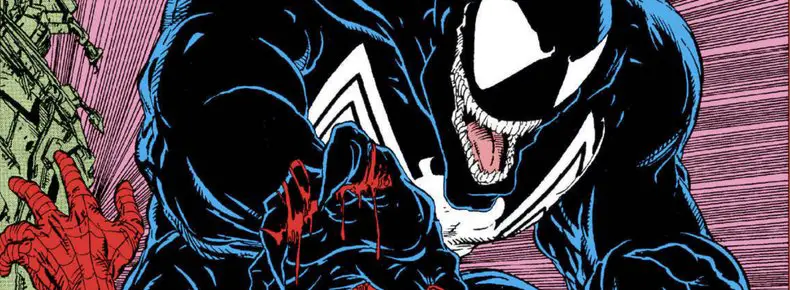The Amazing Spider-Man #316: “Dead Meat”
Venom is back in town, and Spider-Man plans to take the fight to him. Things get serious.
Spider-Man’s ex-girlfriend gets beaten up. His wife is afraid of the shadows. And Spider-Man is covered in dead animal blood and guts.
This is a very weird choice of story to publish on Valentine’s Day.
Where Venom Goes, Chaos and Credits Follow
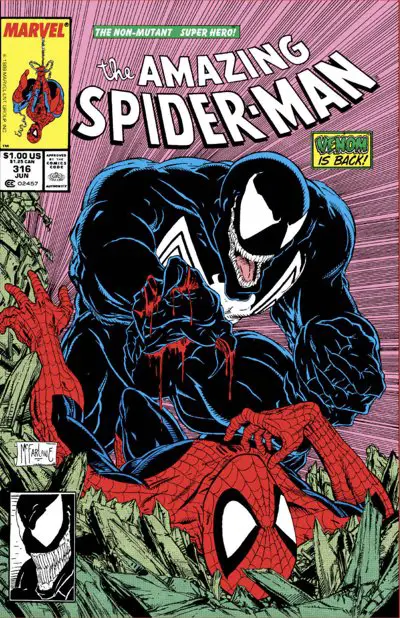
Artist: Todd McFarlane
Colors: Bob Sharen
Letterer: Rick Parker
Publication Date: February 14, 1989
Venom Takes No Prisoners
Two people are looking for Spider-Man in this issue. The first is the Black Cat, who has returned to the city to reunite with her old lover pal, Peter Parker. She’s been gone for so long, though, that she doesn’t know he’s married. She discovers that when she runs into Venom, who is also looking for Spider-Man. He beats up the Black Cat in a way that would create havoc and outrage on the internet in 2022 and then skulks off.
Peter, hearing from Mary Jane that Venom is back in town (because she felt a chill), aims to take the fight to Venom first, so as not to put Aunt May in danger. (Remember, they recently moved in with Aunt May after Jonathan Caesar somehow evicted them from his jail cell.)
After a long night of searching, Spider-Man is tired and ready to call it a night. That, of course, is when Venom strikes. Fisticuffs ensue.
We’ve seen Spider-Man and Venom battle in an abandoned building and on a church rooftop. The next logical place for David Michelinie to have them exchange blows is — a meat packing plant!
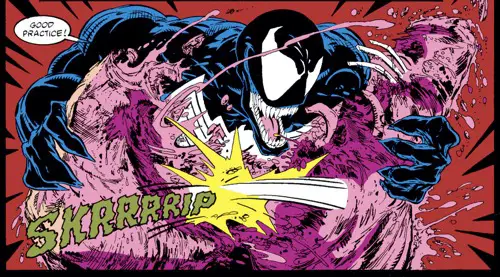
Todd McFarlane gets to draw a warehouse full of butchered meat, where Venom dunks a tank of blood and guts on Spider-Man, who retaliates by dropping a bunch of machinery on top of Venom while he runs off.
By running, of course, he goes against the very reason he went out looking for Venom in the first place. So it is, then, that Venom discovers Peter’s change of address forms and knows where to find him. More on that in the next issue…
Venom – Not Quite Sympathetic, But Kinda Human?
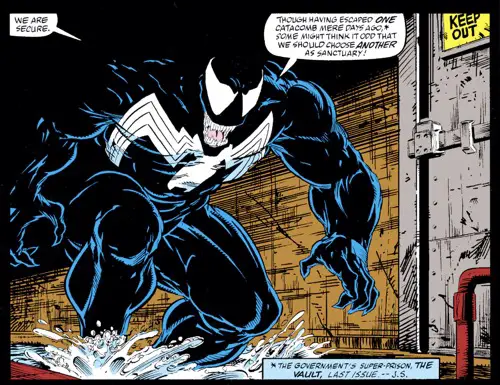
Michelinie pushes hard on Venom’s dual nature as a super-strong villain with mad hatred for Peter Parker, offset by certain noble integrity. He specifically doesn’t bring more harm to people once he believes them.
In the opening scene, a “derelict” encounters Venom, who only lets him live after he can look him in the eye and be honest that this would be their secret. When Venom comes across Black Cat later in the issue, he lets her live because he believes that she doesn’t know where Peter is. He can see it in her eyes.
Granted, he smacked her against the wall, slammed her face into the ground, tore her costume in half, and left her a quivering mess, but he didn’t kill her because she was honest with him.
Aww, what a nice guy.
He was so popular, they gave him his own series and everything. (Everybody remembers “Lethal Protector,” right?)
Again, imagine how well that series of events would go over today…
On-Going Subplots That Will Probably Pay Off Later When Erik Larsen is Drawing The Series, IIRC
In the “civilian” life, Mary Jane’s career is still stalled out, as all her modeling gigs are getting canceled at the last minute. We can all see Jonathan Caesar’s role in this one coming right?
At the Daily Bugle, J. Jonah Jameson is only buying Spider-Man pictures from a new photographer who shares JJJ’s hatred for the webcrawler. Peter is forced to work around those restrictions to find a profitable angle on his business as a freelancer. Even with living “at home,” the Parkers are being squeezed financially at both ends.
How To Tell a Superhero Story
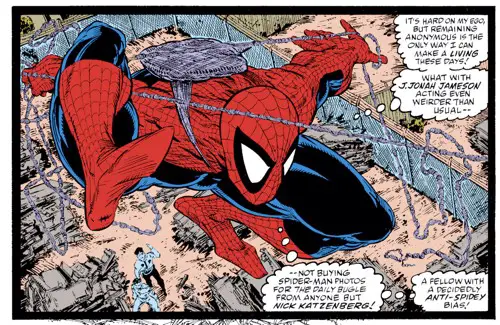
This issue is more good ol’ classic Spider-Man storytelling. It’s not reinventing the wheel. It’s not trying to be super smart by showing how you can retroactively change continuity to bring a new angle to something. David Michelinie is telling a solid superhero story. The clothes are slightly different, but it’s the same person at the core.
Today, especially, in a day and age where every character needs to be destroyed, recreated, and recostumed/recast to be a completely different character with only the barest connection, this feels like sunshine after a rainy day.
And Michelinie’s script treats every issue like it’s someone’s first. Characters talk to themselves to get out the exposition needed to set up the story. Spider-Man is always talking the plot out to himself as he swings magnificently through the city. This stuff didn’t survive the trade paperback era.
Structurally, you can break the issue up into roughly four movements:
- Introduction to the villain: Venom has an “action” beat and then settles down to day-in-the-life stuff while catching us up on what a newcomer would need to understand the character and his motivations.
- Introduction to Spider-Man/Peter Parker: a quick action beat for Spider-Man, some webslinging, and then a day-in-the-life of Peter Parker. Structurally, it’s very similar to the first beat.
- Venom acts, Peter Parker reacts: Heightens the tension. Venom fights Black Cat, Mary Jane sees Venom and warns Peter.
- Spider-Man vs. Venom: Spider-Man hunts down Venom, the two fight.
WIth a 22 page superhero comic, four sections that all have action beats is as complete a package as you can ask for. And the beats make sense. You get proper introductions with a growing tension until the characters go into action and eventually meet up and have their brawl.
Along the way, the subplots of the series and the Spider-Man comics line at the time get smaller movements. The serial story continues…
The Business of Being Peter Parker
Peter has a few lessons to learn as a freelancer. For starters, he relies on a single stream of income which his entire career has proven to be unreliable. He knows that JJJ runs hot and cold with his work. He needs to save some of that money during the good times to survive through the lean times.
At the very least, he should sell his formula for the spider webbing to someone who will give him a sweetheart licensing deal for that amazing tech. Certainly, a glue company would be interested in it, at the very least. I know they didn’t have “Shark Tank” yet in 1989, but that’s what Peter needs – a Mr. Wonderful royalty deal.
I can picture Dan Slott writing the issue where Spider-Man goes on Shark Tank, makes a deal with Mr. Wonderful, but then it all falls through afterward during due diligence for some superhero nonsense reason. Maybe Reed Richards already patented some kind of prior art that makes the deal unprofitable?
McFarlane Glues Together a Page
Todd McFarlane is at ease in this issue. There are only three pages out of the 22 in the issue where there isn’t a costume present. He has a lot of characters to draw, but never more than two of them at a time in a given scene.
It gives him room to have a splashy and sexy introduction to the Black Cat, as well as some scary Venom panels and some classic shots of Spider-Man swinging through the city. We can never get enough of those, thankfully.
He does sneak in a couple of shortcuts as one splash page and one half-page panel use a photocopy of New York City buildings as the background. One of those pages showed up on Heritage Auctions, so we have a high-resolution scan of it to study how the page was produced. Here’s a segment from it so you can see what I’m talking about:
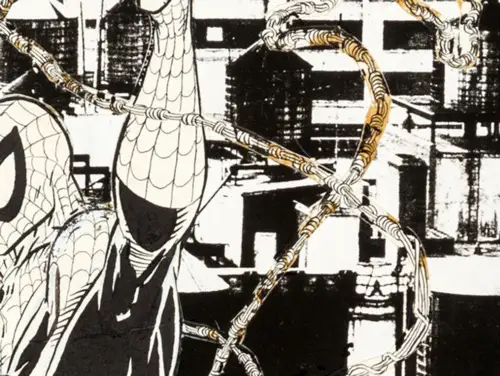
The glue is drying yellow, which is pretty standard on original art, sadly. Glue never ages well.
Looks like the background is drawn on the paper first, though I’m not sure what tech was used to do it. Could you photocopy an image enough times to break it down to something as rough as you see here, and then photocopy that directly onto the Bristol Board? Was it lightboxed and then drawn roughly that way? It’s clear that there’s some extra inking done on top of it to define a few things, particularly on the left half where things started to fade more seriously.
A separate image of Spider-Man is drawn, cut out carefully, and glued on top. Then, some extra inking is done to make sure the background appears to show through the webbing so there isn’t a jarring negative zone behind it.
That all starts to sound like an awful lot of work in order to save on drawing a background from scratch. On the other hand, sometimes it’s easier to do the rote work of inking what’s there or photocopying it a couple times more than doing the more tedious work of drawing out perspective grids and placing the buildings in believable places and making it look right.
The page sold for over $31,000, by the way. That was in 2014, though, so it’d probably go for much more today.
McFarlane is really hitting his stride on this series now. We’re still between bi-weekly runs, so he has enough time to devote to each issue. He’s comfortable with all the regular characters in the series. He’s established his style and his vision of all the characters that David Michelinie can fit into his scripts.
Artistically, I could make the argument that this issue and the next three comprise the best streak of issues in McFrlane’s run. He later finishes on a couple of very strong issues, but the bi-weekly schedule that comes up between now and then ruins his art and results in some fill-in issues.
We’ll get to those soon enough…
Hidden Spiders
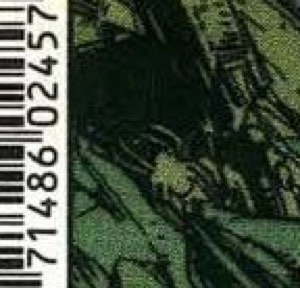
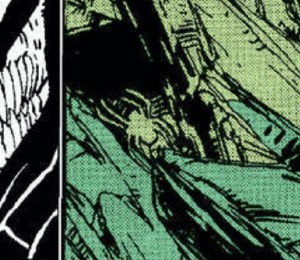
This one is subtle, but it’s hidden precisely where you’d expect to find it — in a pile of rubble.
Look next to the UPC code, just underneath Spider-Man’s left shoulder.
The newsstand edition made it harder to find since there wasn’t a big difference in the shades of green used in the rubble. It stands out a bit more in the digital and Omnibus editions. In both cases, having that big spot of filled-in blacks helps, too.
This is a popular cover all of a sudden. Recently, an homage to it was announced for a Batman comic, where the character in the Spawn position is blacked out for spoiler’s sake.
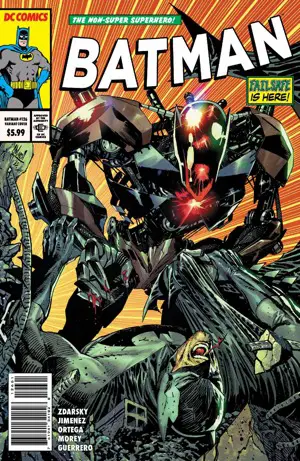
The cover was drawn by Guillem March, who is no stranger to European comics. I reviewed his “Karmen” here, but he has other albums available in English if you poke around a little…
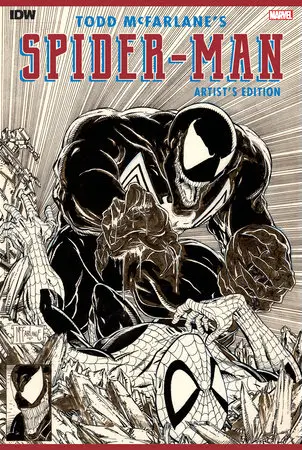
Also, the original art for the cover was used for the cover of IDW’s Artist’s Edition of Todd McFarlane’s Spider-Man.
This is where many people noticed for the first time that the speed lines in the background have multiple vanishing points.
That’s at least three that I can count. That’s just… weird. And slightly hypnotic.
Felix Watch
It’s a two-fer this month! Two Felixes (“Felices”?) in one panel!
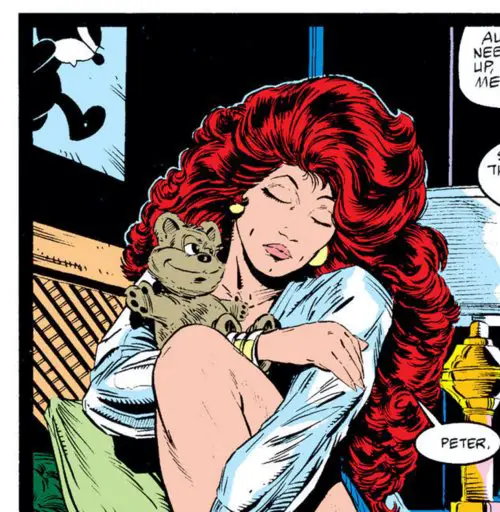
He’s there, pacing back and forth on the wall of the room Mary Jane and Peter share at Aunt May’s place.
He’s also a stuffed animal Mary Jane is cuddling. Did she bring that with her from their upscale condo? Or was that a leftover friend of Peter’s from his childhood?
Next issue
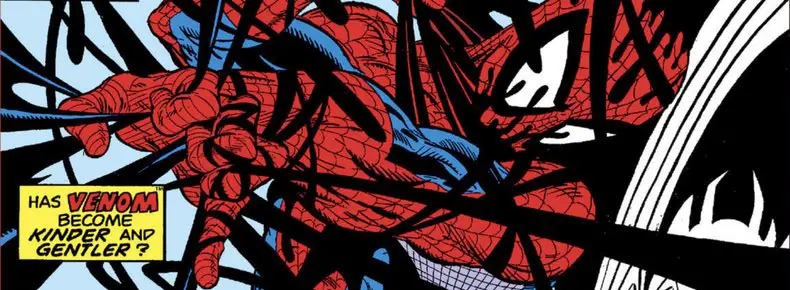
Spider-Man vs. Venom! Aunt May and The Thing! Peter in his Underoos! Political references from the 1988 presidential election! It’s a classic!

